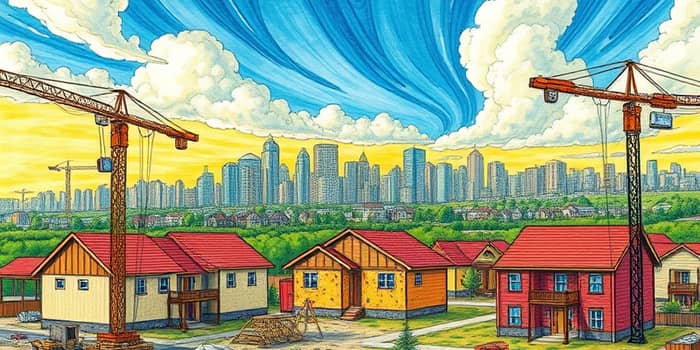
The U.S. housing market entered a period of cautious adjustment in the spring of 2025 as builders and buyers alike reacted to rising borrowing costs. While underlying demographic pressures and supply shortages persist, the immediate effect has been a slowdown in new home construction and permit activity.
In May 2025, total housing starts declined by 9.8% month-over-month to an annualized 1.26 million units, marking the steepest single monthly drop since mid-2023. Single-family starts held relatively steady at 924,000 units, virtually unchanged from April’s revised 920,000 figure. By contrast, the multi-family segment showed more volatility, reflecting shifting preferences and financing challenges.
1.26 million units in May highlights the immediate cooling effect that higher rates can have on builder activity. Building permits, a key leading indicator, also fell by 2.0% from April to 1.393 million units. On a year-over-year basis, permits are down 1.0% compared to May 2024.
Housing completions, however, reached 1.526 million units in May, a notable increase spurred by projects initiated during 2022’s peak activity. This divergence between starts and completions suggests that while pipelines remain active, new ground-breaking faces headwinds.
Regional trends underscore the uneven nature of the slowdown. In April 2025, the Northeast and South posted gains of 12.9% and 11.0%, respectively, buoyed by local demand and resilient labor markets. Meanwhile, the Midwest saw a 10.8% decline, and the West experienced a sharper 16.1% drop, driven by higher land and labor costs.
Local policy and zoning reforms in some Sun Belt markets have eased certain restrictions, supporting starts despite rising financing costs. However, high construction expenses and scarce labor in coastal metros continue to constrain supply.
After dipping to as low as 6.2% in September 2024, the average 30-year fixed mortgage rate climbed above 7% in early 2025 before settling around 6.94% by late May. Elevated rates have dampen affordability and discourage potential buyers, particularly first-time purchasers squeezed by slow wage growth and high home prices.
Inventory levels are slowly improving but remain historically low. At the end of April 2025, existing homes for sale were up roughly 20% year-over-year, yet still 20–30% below troughs seen during previous tight markets. New homes for sale reached 481,000, the highest since 2007, and speculative inventories rose to 385,000, the most since 2008.
4.4-month supply of homes indicates the market remains slightly below the 5–6 month benchmark for a balanced environment. In many regions, builders face material cost inflation, labor shortages, and supply chain delays, slowing the conversion of permits into starts.
The single-family segment has shown resilience relative to multi-family, partly because of stronger demand from move-up buyers and the desire for more private space following the pandemic. Yet, single-family starts are unlikely to climb significantly without improved affordability or policy incentives.
Multi-family developments, including build-to-rent projects, continue to attract institutional investment. Analysts expect this trend to persist as rental demand remains high and financing structures for multi-family projects prove more flexible than those for detached housing.
Forecast revisions have been broadly downward: nine out of eleven major forecasters lowered 2025 starts projections during the first half of the year. Most expect starts to remain subdued until at least mid-2026, when higher completions and potential rate relief could stimulate new construction.
Tariff uncertainties and rising government debt levels have kept inflationary pressures elevated, supporting higher long-term rates. The transition under the new presidential administration in 2025 adds another layer of uncertainty, with potential shifts in housing subsidies, tax incentives, and infrastructure spending.
Demographic headwinds—slower population growth, aging households, and reduced immigration—are reshaping demand patterns and could temper long-term construction needs even after affordability improves.
Builders should monitor financing conditions closely and consider alternative funding sources such as build-to-rent partnerships. Buyers may benefit from locking in rates when possible and exploring adjustable-rate mortgage options for short-term savings.
Policymakers can alleviate supply constraints by streamlining permitting, investing in workforce development, and considering targeted subsidies for affordable and workforce housing.
The current cooling in U.S. housing starts underscores the delicate balance between financing costs, supply constraints, and demographic demand. Although higher mortgage rates have temporarily slowed ground-breaking activity, the underlying shortage of homes ensures that demand will re-emerge once financial conditions stabilize.
Ultimately, collaboration among builders, lenders, and policymakers will be essential to address supply bottlenecks, improve affordability, and guide the market toward sustainable growth by the latter half of the decade.
References













